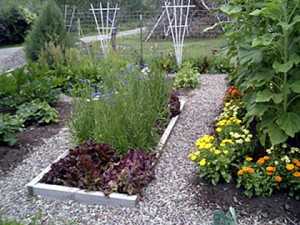 Nowadays it is been commonly seen that everything vegetable and fruits in market available is loaded with artificial color and made ripe through chemicals, thus reducing there nutrition intake and making them a hazard to our health.
Nowadays it is been commonly seen that everything vegetable and fruits in market available is loaded with artificial color and made ripe through chemicals, thus reducing there nutrition intake and making them a hazard to our health.
If you have adequate space, with a little bit of effort you can get fresh organic food straight from your very own kitchen garden and get fresh vegetables.
But however, if space is a constraint many herbs and vegetables can even flourish in pots, growing bags and window baskets.
– Find place for your Kitchen garden
For a family of 6 a 200 square meter plot can take care of the food stock. There should be good sunlight available everyday for at least 4 hours. Tomatoes, cucumbers and other fruiting vegetables cannot grow without substantial sunlight. While sunlight is good for root vegetables like beets and carrots, leafy vegetables need more shade.
– Soil Preparation
Spring is the right time for maximizing the growth factors of soil. You can have a raised bed near your house that will get its required dose of shade from the roof. Soil can be improved by adding some red earth. Your plot will be ready for sowing after it has been tilled.
– Keep a check on seeds before sowing
While buying seeds check their sowing season, sowing and spacing technique. For leafy vegetables you can sprinkle the seeds and cover them with more soil. For others you might need furrow planting while some can be transplanted.
– Adequate Supply of Water and Fertilizers
By adding organic fertilizers or manures you improve absorption, biochemical stimulation and growth in plants. Manures also add nutrients to the soil. Another crucial factor for plant growth is water. However, you cannot water the kitchen garden the way you water your flower pots. These plots need abundant supply of water. Your vegetable garden needs regular irrigation for 10 days after sowing. You can then bring it down to twice or thrice every week. The soil should never be totally dry, it needs constant moisture.
– Prevent your garden from diseases, weeds and pests
Your lovely little kitchen gardening would need vigilant weeding. Pests and insects can be kept away by natural methods like companion gardening. For example, grow basil and tomatoes close by. Basil attracts bugs that eat the pests which bother tomatoes. Sadly, in some urgent cases a pesticide can be the only way to save your plants. In such cases go for microbial pesticides, botanical pesticides and pesticides manufactured from petrochemicals. Botanical pesticides, for example, quickly break down after exposure to heat or water causing far less damage than synthetic pesticides.
– Harvesting
This is the moment every kitchen gardener waits for. Harvesting is your time to pluck the fruits of your labor. Remove the ripe vegetables as soon as they mature to avoid rotting. Your kitchen garden will thrive with your seeds of effort and patience. After a couple of months, all you need to do is walk down to your own vegetable market to get a bag full of healthy foods.
I would love you to leave me a comment and let me hear your opinion. If you’ve got any thoughts, comments or suggestions for things we could add, leave a comment.























